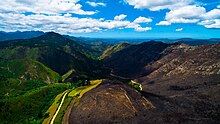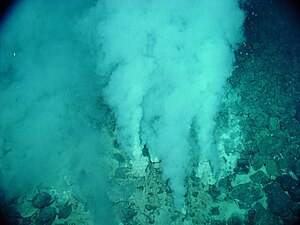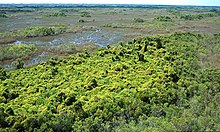| |
|
|
Ecology
|
|
Ecology (from Ancient Greek οἶκος (oîkos) 'house', and -λογία (-logía) 'study of') is the natural science of the relationships among living organisms, including humans, and their physical environment. Ecology considers organisms at the individual, population, community, ecosystem, and biosphere levels. Ecology overlaps with the closely related sciences of biogeography, evolutionary biology, genetics, ethology, and natural history. Ecology is a branch of biology, and is the study of abundance, biomass, and distribution of organisms in the context of the environment. It encompasses life processes, interactions, and adaptations; movement of materials and energy through living communities; successional development of ecosystems; cooperation, competition, and predation within and between species; and patterns of biodiversity and its effect on ecosystem processes. Ecology has practical applications in conservation biology, wetland management, natural resource management (agroecology, agriculture, forestry, agroforestry, fisheries, mining, tourism), urban planning (urban ecology), community health, economics, basic and applied science, and human social interaction (human ecology). The word ecology (German: Ökologie) was coined in 1866 by the German scientist Ernst Haeckel. The science of ecology as we know it today began with a group of American botanists in the 1890s. Evolutionary concepts relating to adaptation and natural selection are cornerstones of modern ecological theory. Ecosystems are dynamically interacting systems of organisms, the communities they make up, and the non-living (abiotic) components of their environment. Ecosystem processes, such as primary production, nutrient cycling, and niche construction, regulate the flux of energy and matter through an environment. Ecosystems have biophysical feedback mechanisms that moderate processes acting on living (biotic) and abiotic components of the planet. Ecosystems sustain life-supporting functions and provide ecosystem services like biomass production (food, fuel, fiber, and medicine), the regulation of climate, global biogeochemical cycles, water filtration, soil formation, erosion control, flood protection, and many other natural features of scientific, historical, economic, or intrinsic value. (Full article...) Selected article - In ecology, a disturbance is a temporary change in environmental conditions that causes a pronounced change in an ecosystem. Disturbances often act quickly and with great effect, to alter the physical structure or arrangement of biotic and abiotic elements. A disturbance can also occur over a long period of time and can impact the biodiversity within an ecosystem. Major ecological disturbances may include fires, flooding, storms, insect outbreaks and trampling. Earthquakes, various types of volcanic eruptions, tsunami, firestorms, impact events, climate change, and the devastating effects of human impact on the environment (anthropogenic disturbances) such as clearcutting, forest clearing and the introduction of invasive species can be considered major disturbances. (Full article...)Selected image -Some Hydrothermal vents support peculiar ecosystems, based on dissolved minerals. Hydrothermal vent communities are able to sustain such vast amounts of life because vent organisms depend on chemosynthetic bacteria for food. The water that comes out of the hydrothermal vent is rich in dissolved minerals and supports a large population of chemo-autotrophic bacteria.
General imagesThe following are images from various ecology-related articles on Wikipedia.
Related WikiProjectsThings you can do
Entries here consist of Good and Featured articles, which meet a core set of high editorial standards.
Invasive species in the Everglades are exotic plants and animals that are not native to the area and have aggressively adapted to conditions in wilderness areas in southern Florida. The Everglades are a massive watershed in the southern portion of the U.S. state of Florida that drains overflow from the vast shallow Lake Okeechobee that is in turn fed by the Kissimmee River. The overflow forms a very shallow river about 60 miles (100 km) wide and 100 miles (160 km) long that travels about half a mile per day. The network of ecosystems created by the Everglades are surrounded by urban areas to the east in the South Florida metropolitan area, to the west by Naples and Fort Myers, and to the south by Florida Bay, a marine environment that receives fresh water from and is maintained by the Everglades. As it is surrounded on three sides and close to a major transportation and shipping center, it is particularly vulnerable to the importation of exotic species. In the 20th century, Florida experienced a population surge unparalleled in the U.S., accompanied by rapid urban expansion made possible by draining portions of the Everglades. Flood control became a priority and the Central & South Florida Flood Control Project, from 1947 to 1971, constructed over 1,400 miles (2,300 km) of canals and flood control structures in South Florida. The widespread building created new habitats and disturbed established plant and animal communities. Many of the new residents or tourists in Florida were responsible for introducing plant species to the area by accident, or deliberately to improve landscaping. Many animals have been introduced similarly, and have either escaped or been released to proliferate on their own. Several terms are used to identify non-native species: exotic, invader, immigrant, colonist, introduced, nonindigenous, and naturalized. "Naturalized" usually refers to species that have adapted to a region over a long period of time, while "invasive" refers to particularly destructive or aggressive species. (Full article...)Selected biography - Ann Fowler Rhoads (born 1938) is an American botanist who worked as a plant pathologist at Morris Arboretum for 36 years, retiring in 2013. She is the co-founder (with Timothy A. Block) of the Pennsylvania Flora Project of Morris Arboretum. In addition, Rhoads is a former Adjunct Professor at the University of Pennsylvania and a former Research Associate at the Academy of Natural Sciences. Rhoads has written and edited 6 books. Her most important work is The Plants of Pennsylvania: An Illustrated Manual, which she coauthored with Timothy Block. It has been called the "Bible of our state's plant life". It is particularly significant “because most states simply don’t have such a comprehensive work on regional flora. Relevant to plant life found in much of the Northeast, the book has also been requested in neighboring states." A second edition was published in 2007. (Full article...)Did you know (auto-generated)
Selected quote -
Ecology news
Additional News Highlights
Selected publication -Ecotropica is a biannual, peer-reviewed international scientific journal covering all aspects of tropical ecology. Papers reflect results of original research (major papers, short communications) or review important fields in tropical ecology. (Full article...) Related portalsMore did you know -Related articlesAssociated WikimediaThe following Wikimedia Foundation sister projects provide more on this subject:
Web resources
Discover Wikipedia using portals |



















































Recent Comments